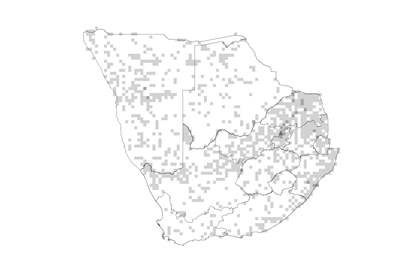 Species distribution and density. Darker squares represent higher density of members of this family. |
Introduction
(excluding Chenopodiaceae)
Amaranth family
The family includes several cosmopolitan weeds in disturbed areas and agricultural fields. It is better known for its important exotic vegetable and grain crops and a few decorative species than for the species indigenous to southern Africa.
Distribution
A widespread and cosmopolitan family of the subtropical and tropical regions in America and Africa. Many of the indigenous southern African species are restricted to the drier, warmer summer-rainfall areas of the country.
Number of genera in the world
ca. 69
Number of species in the world
ca. 1 000
Number of genera in the Flora of southern Africa region
24
Number of species in the Flora of southern Africa region
84
Well-known southern African genera
Amaranthus, Calicorema, *Guilleminea, Hermbstaedtia, Sericocoma.
Growth forms
Mostly annual or perennial herbs or small shrubs with a woody base. The indigenous species are often xerophytic.
Habitats
The indigenous species often grow in dry, sandy areas, whilst the cosmopolitan species are mostly found in weedy situations in cultivated or disturbed areas.
Flagship species
Hermbstaedtia odorata (cat's tail; rooiaarbossie [A]; ubuphuphu [Z]) is widespread in grassland areas and flowers in summer. Plants are 300-600 mm tall with long narrow leaves. Numerous stems are produced from a perennial rootstock, bearing white, red or pink flowers in spike-like inflorescences. In Botswana the plants are used medicinally to treat depressed fontanelle in babies and gonorrhoea in adults. (Photo: HV).
Significance of the family
The seeds of amaranth species, e.g. Inca wheat (*Amaranthus cruentus) are edible and used as cereals or ground for flour and porridge. Seeds are high in protein and have become a popular health food. As a vegetable crop, Amaranthus is one of the highest yielding and most nutritious crops in the tropics where the leaves of several species are used as a potherb. In South Africa there are even some commercial plantings and the vegetative parts (marogo) are canned. Some species are eaten like spinach, as green vegetable or in salads, e.g. Chinese and duck's spinach (*Amaranthus tricolor, *A. viridis). A few species are weedy, and a number of species are popular garden ornamentals, e.g. cockscomb (*Celosia).
Diagnostic characters
Leaves alternate or opposite, stipules absent. Flowers very small, regular, and in spike-like structures surrounded by dry, often spiny, bracts . Sepals 5, free, dry and membranous . Filaments united into a short tube at the base. Fruit dry, opens with a lid.
Did you know?
Amaranth seeds are gluten-free and the seeds of some species can be puffed and popped like popcorn.